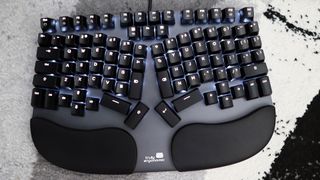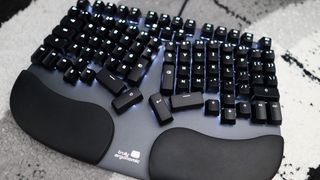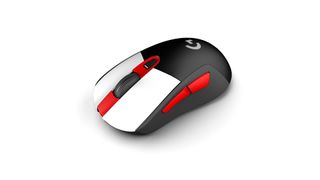Yes, you can absolutely game on an ergonomic keyboard
But should you?

The world of gaming keyboards is a funny old business. In the last few years, we’ve seen everything from analogue switches to low profile ones, to ones with OLED displays and a shedload more. So, essentially it’s become a case of anything goes.
In the past, I’ve recommended you try out 60% keyboards for gaming, as well as to join the club of electro-capacitive keyboards. It seems I’ve developed a small reputation at PC Gamer for being the freelance lad to test enthusiast-level keyboards for gaming and report back my findings, trying out an ergonomic keyboard for gaming seemed to be the next logical step.
First things first: what makes a keyboard ergonomic? Well, in the case of candidates like this Truly Ergonomic Cleave I’ve had the pleasure of using for the past couple of weeks, they usually offer a different style of layout. This comes in the form of splitting the keys into clusters in part so you don’t have to reach your wrists over too much so they don’t get strained, as well as angling the individual keys slightly to suit a more natural wrist position. All things considered, there’s a bit of a learning keyboard from moving to a bog-standard keyboard like Unicomp New Model M I’ve been using to using an ergo-specific board like the Cleave.
“Alright keyboard boy, get to the point”, you’re probably requesting—okay then, can you game on an ergonomic keyboard? In short, you can, with practice. It’s not a seamless transition by any means, in the same way moving from a standard keyboard to an ergonomic board to simply type requires a bit of practice. However, once you’ve learned to use the keyboard in a couple of weeks and learn the quirks of the layout, you certainly can give it a go.
The reason for there being a bit of a learning curve is majorly down to differing key placement and the large split in the middle of the board itself. For the first few games, it may be natural to contort your hands a little to try and reach some keys, especially if you don’t type in a traditional way. For instance, I majorly use the index and middle fingers to type and move my hands across the invisible split of keys between G & H on the home row to mash keys when writing. As such, learning to game wasn’t half a bit fiddly at first, but that’s down to the quirks of the Cleave I’ve been using.
You can definitely game on an ergonomic keyboard, as long as you’re willing to put the hours in to try and use the board properly.
All in all, it probably took a good two to three weeks before I felt somewhat confident in using this Truly Ergonomic board to type on, and even now, a little bit later, I'm still not fully comfortable. Once I'd got a couple of weeks in and learnt where the keys were, gaming became a lot easier, and it only took a matter of days to become vaguely competent.

Ergonomic keyboards can come in all shapes and sizes, and the Cleave is perhaps one of the weirder looking options. Other candidates, such as the Kinesis Freestyle 2 simply split the traditional keyboard in half, as opposed to offering an adjusted layout designed with productivity in mind that follows the natural line of your wrist. Using one of these to game is likely to be easier, given everything looks a lot more familiar - there’s just a hinge in the middle so you can adjust the actual angle of the keyboard, if you want to. You could opt to use a sculpted keyboard, like the Kineses Advantage 2 if you want, with a deep dish style layout, although this would be extra fiddly, and you probably wouldn’t be able to game on it at all.
The biggest gaming news, reviews and hardware deals
Keep up to date with the most important stories and the best deals, as picked by the PC Gamer team.
Of course, your user experience will depend on the types of games you're playing. For FPS games, these will be a little more fiddly than if you’re playing a simulator where the pace is a little slower, and hitting certain button combos is of little importance, for instance.
All things considered though, you can definitely game on an ergonomic keyboard, as long as you’re willing to put the hours in to try and use the board properly. My best advice would be to set aside upwards some time just typing random things into a Word document to just get used to typing on it, and then once you’re feeling comfortable, load up some of your favourite titles and give it a go. With time, you’ll become more acquainted with the keyboard itself, and therefore with how to get the most out of it when gaming.


Best gaming mouse: the top rodents for gaming
Best gaming keyboard: your PC's best friend...
Best gaming headset: don't ignore in-game audio
But, here arises another question: should you game on an ergonomic keyboard? Whilst it’s certainly possible to, more ergonomic boards aren’t majorly designed with gaming in mind. Sure, they may have optical, mechanical switches inside, as the Cleave does, which is becoming a key part of the gaming keyboard canon these days, but it doesn’t have the high polling rate than other gaming keyboards have. Sure, it has full NKRO and anti-ghosting which is incredible generally for gaming keyboards, but here, it’s more for peace of mind than precision. Just because you can do something doesn’t mean you should, after all.
So, to sum up, am I telling you to go down to your local hardware store, or head online, and pick yourself up an ergonomic keyboard just for the sake of slapping up the competition in your favourite games? No, I’m not. Ergonomic keyboards are, after all, designed to provide a comfortable typing experience chiefly, and if this is what you're looking for, you’re more than welcome to pick one up. What you do with it after that is completely up to you.
Most Popular


